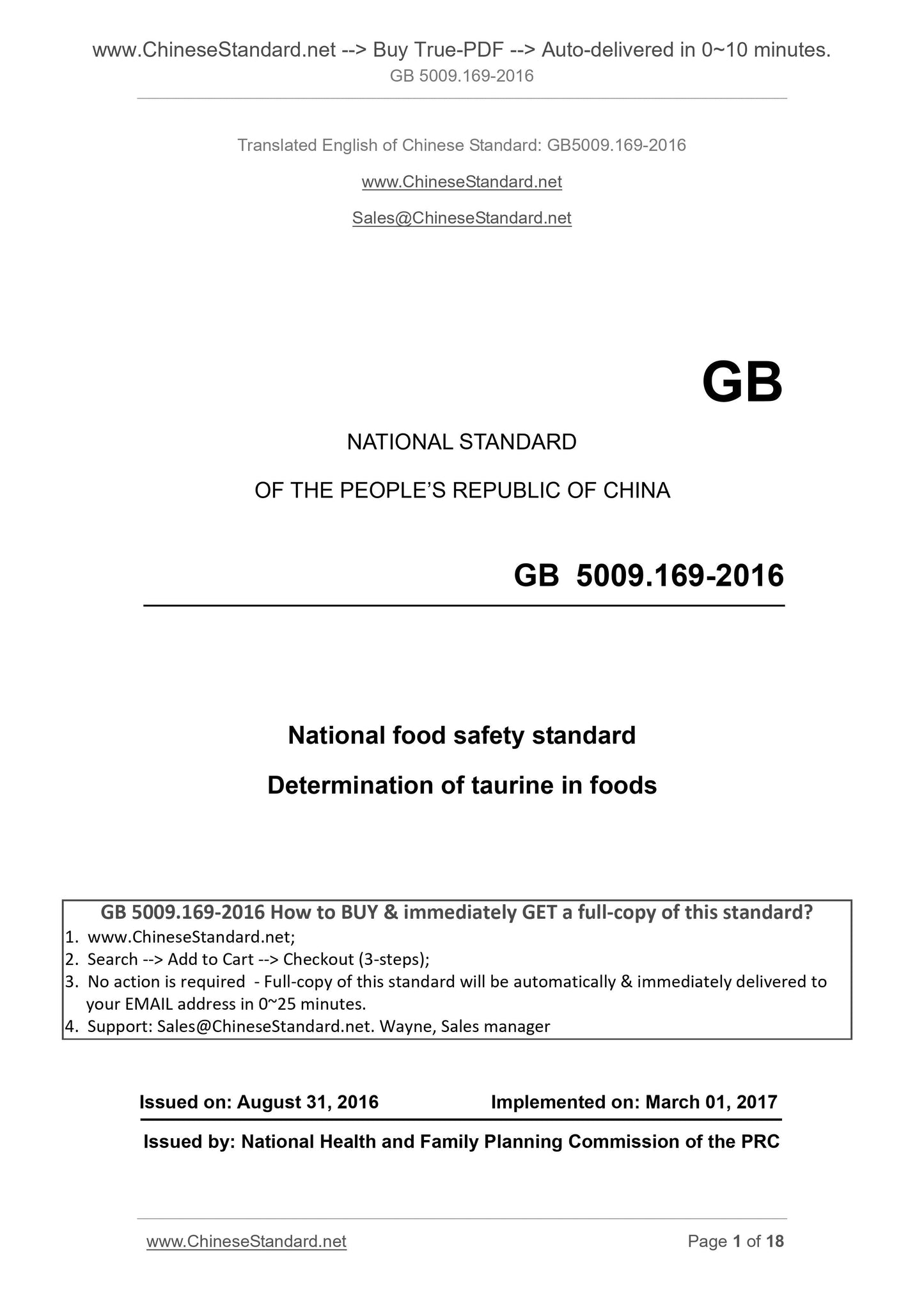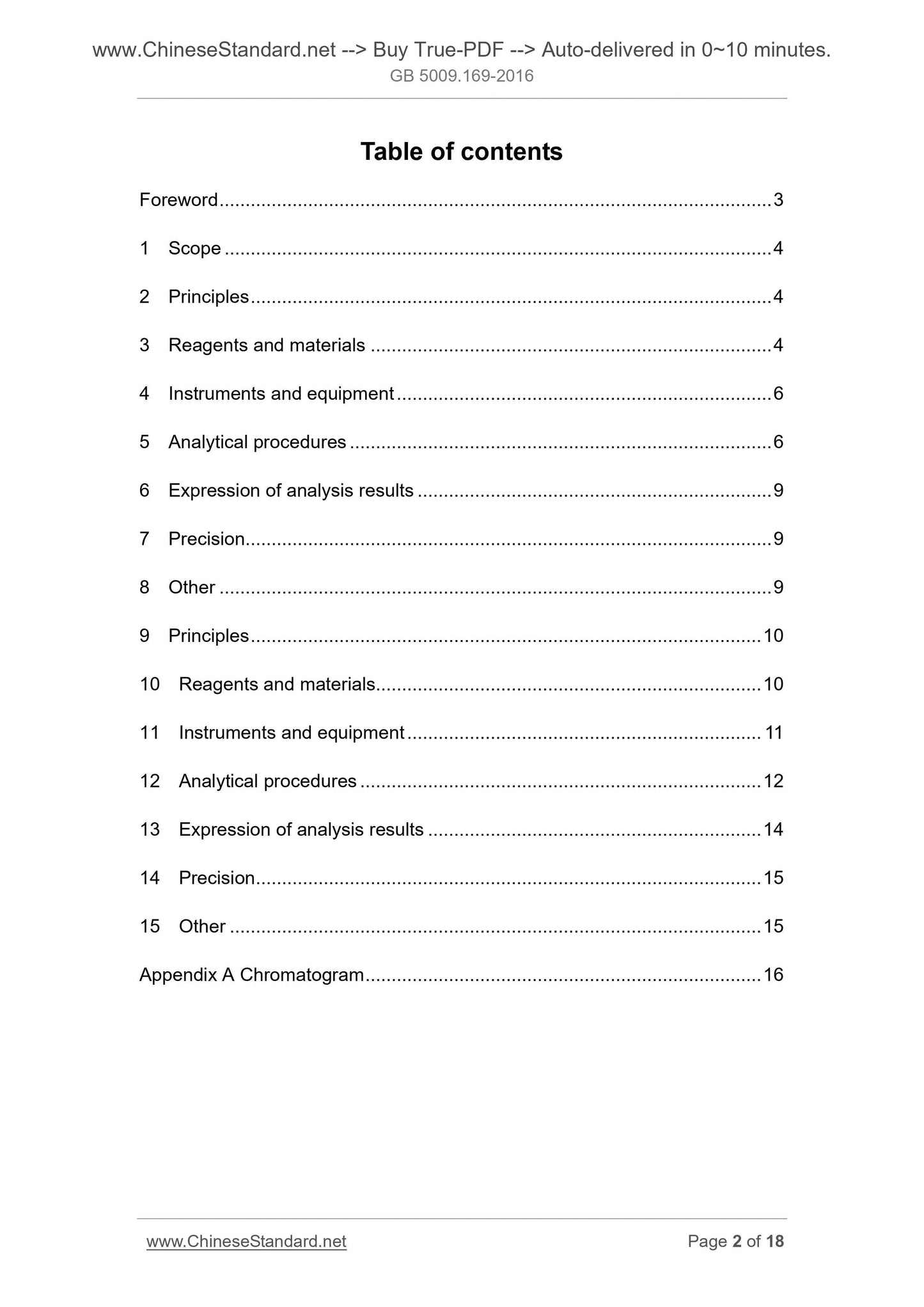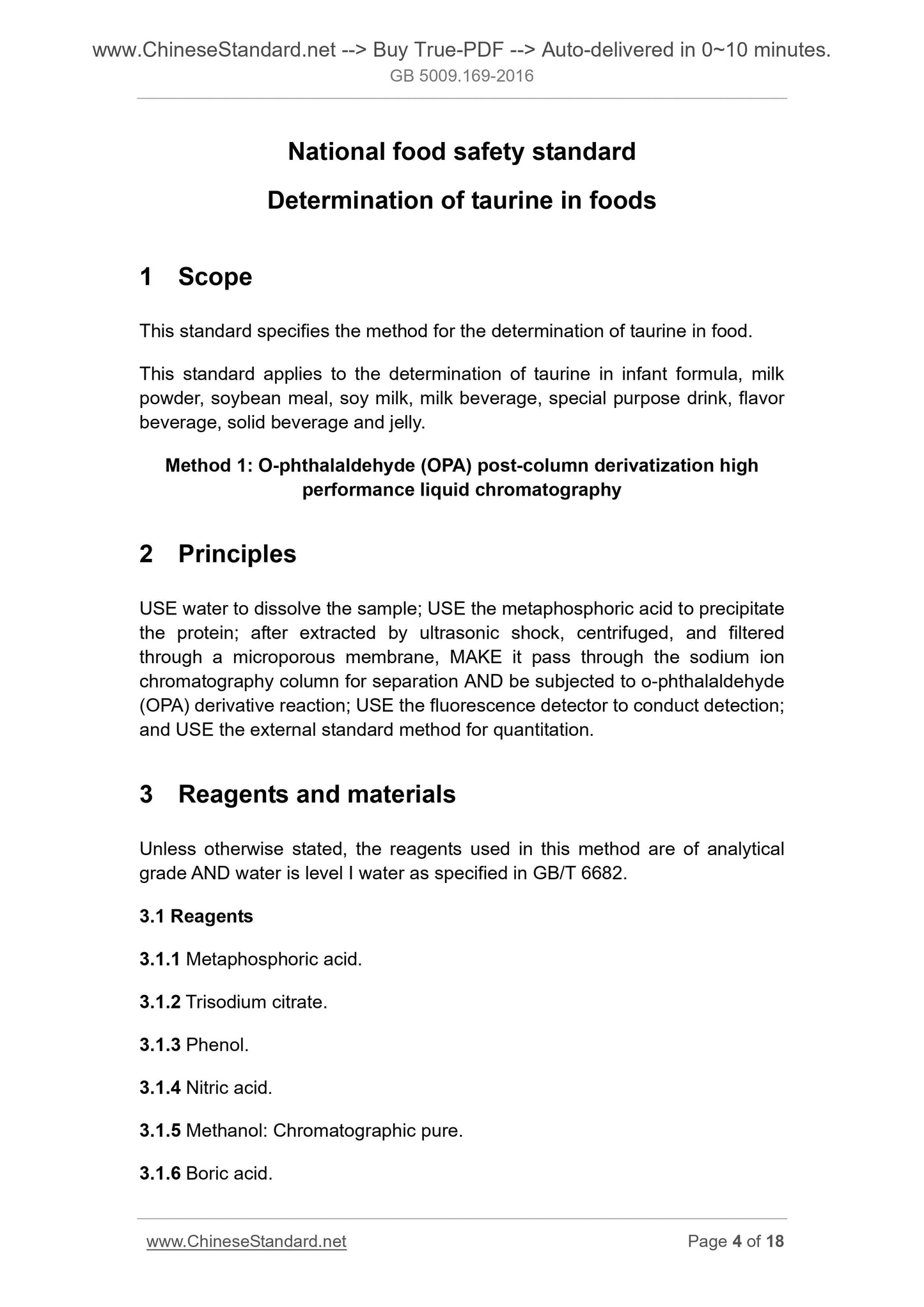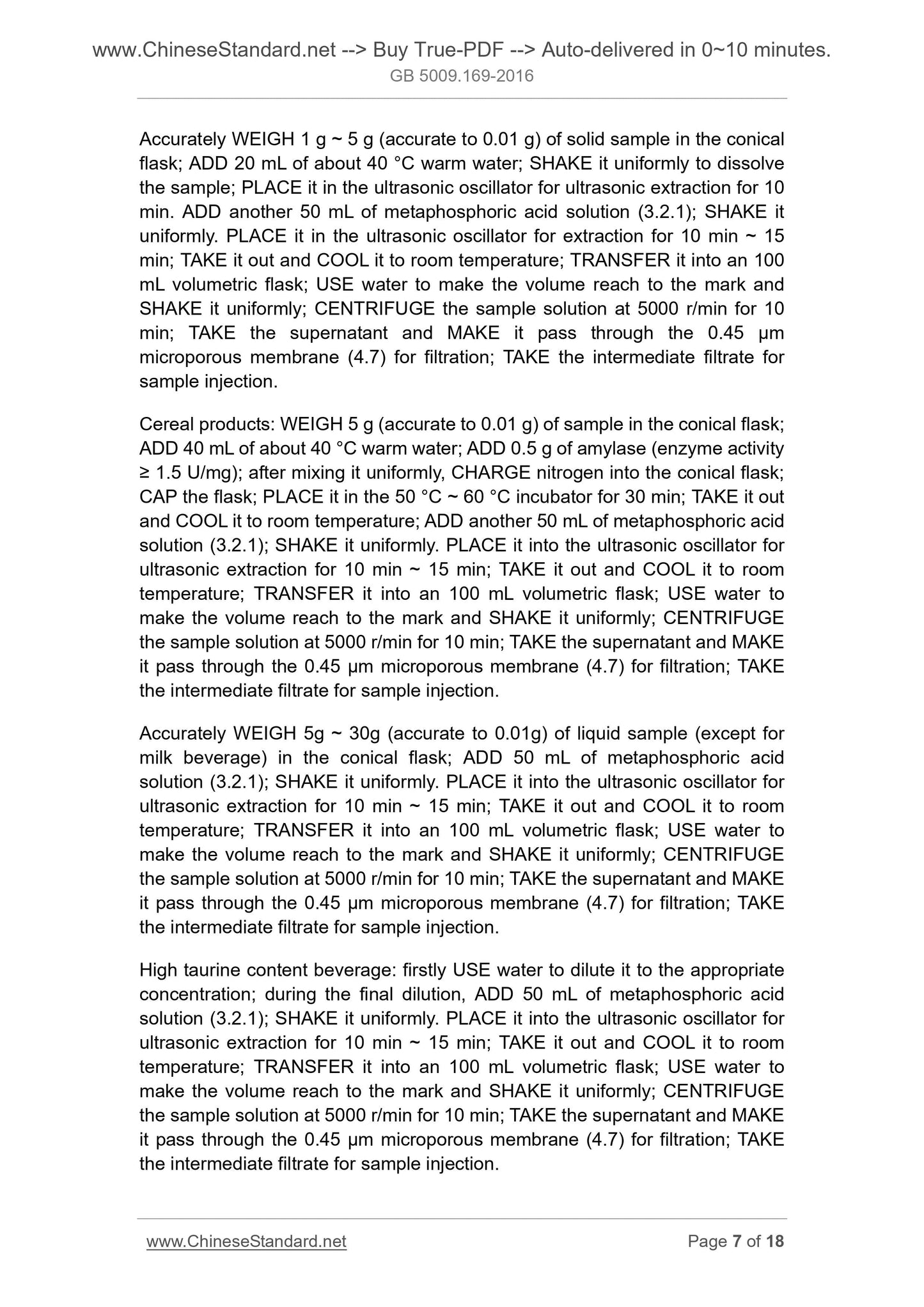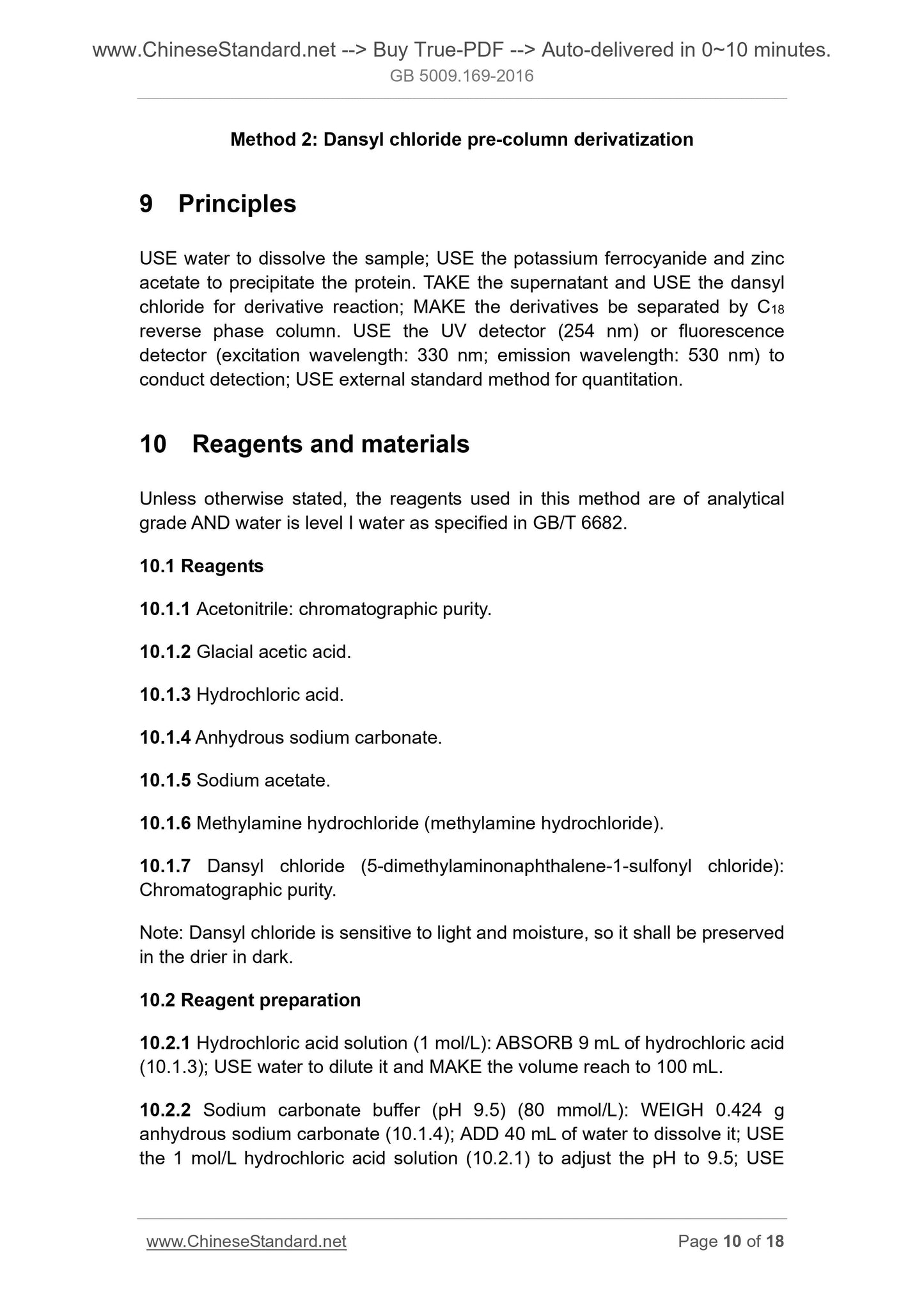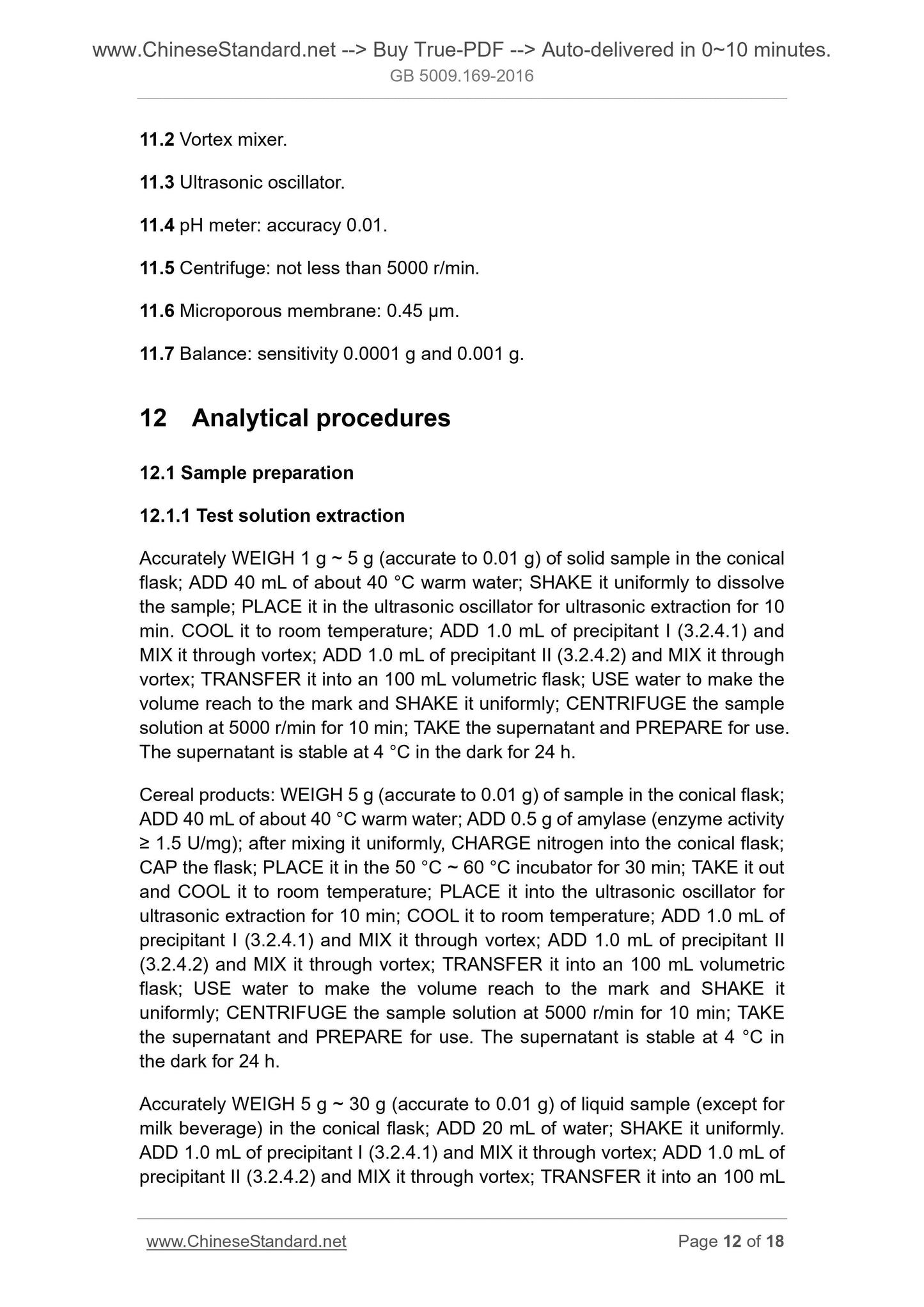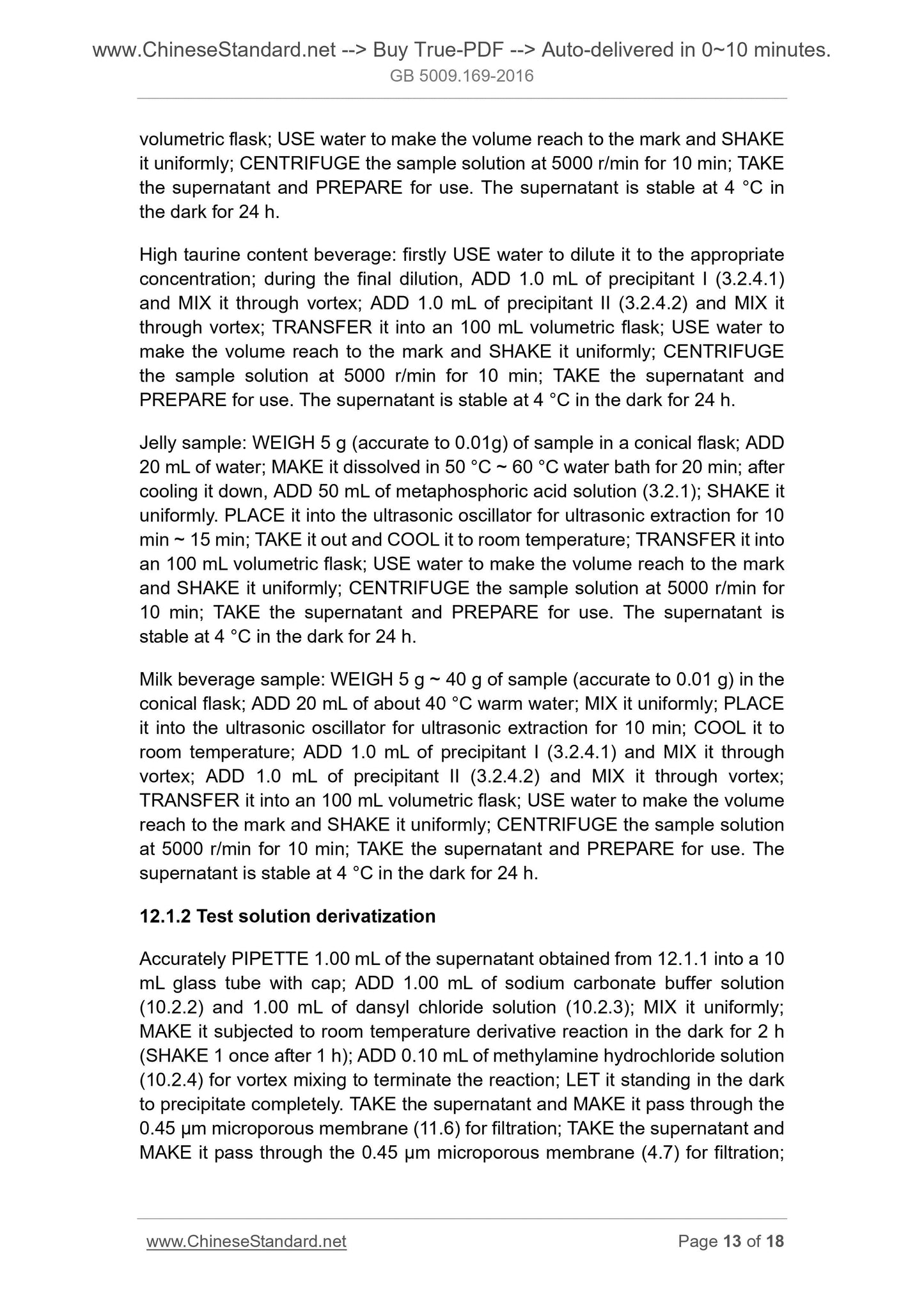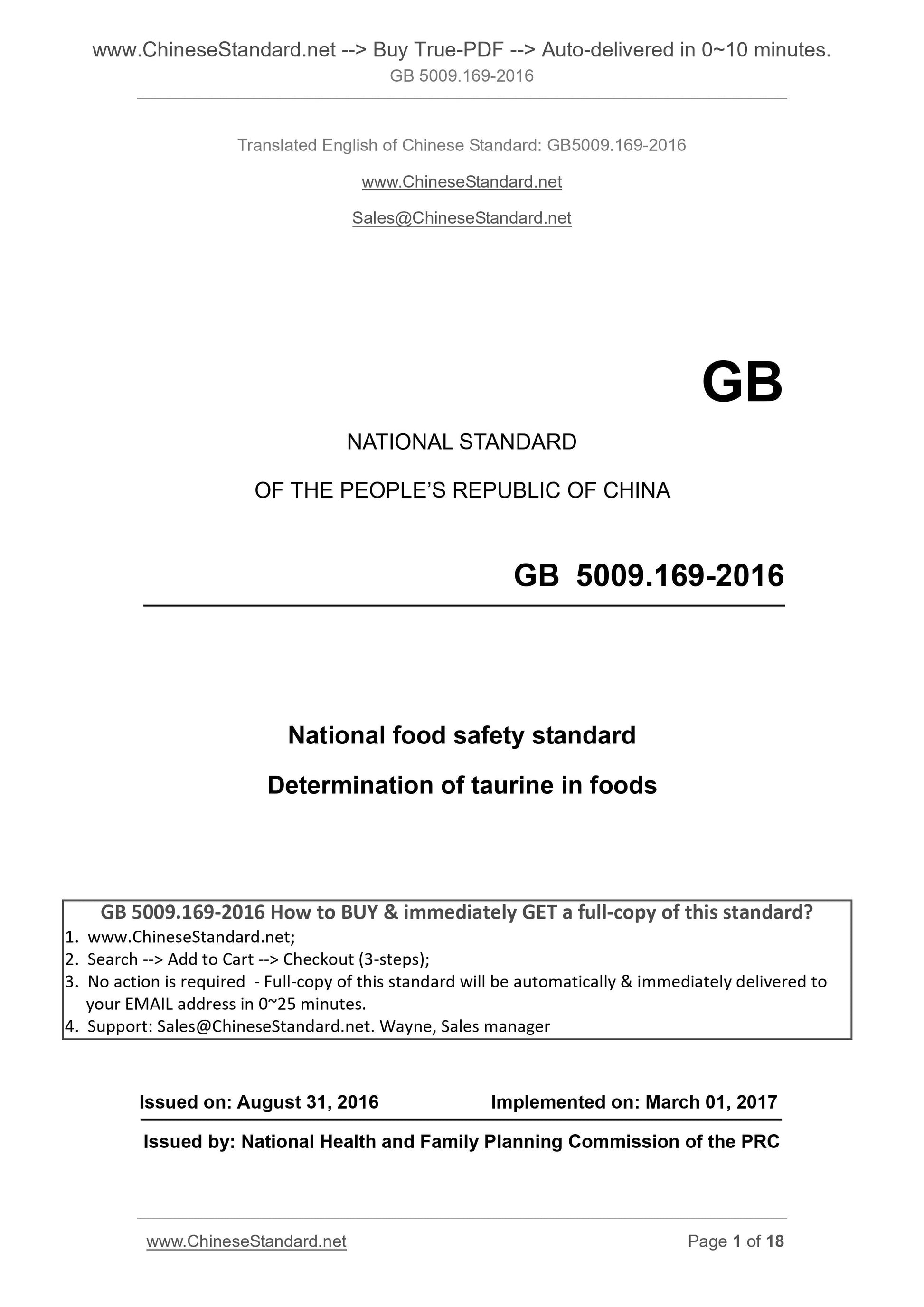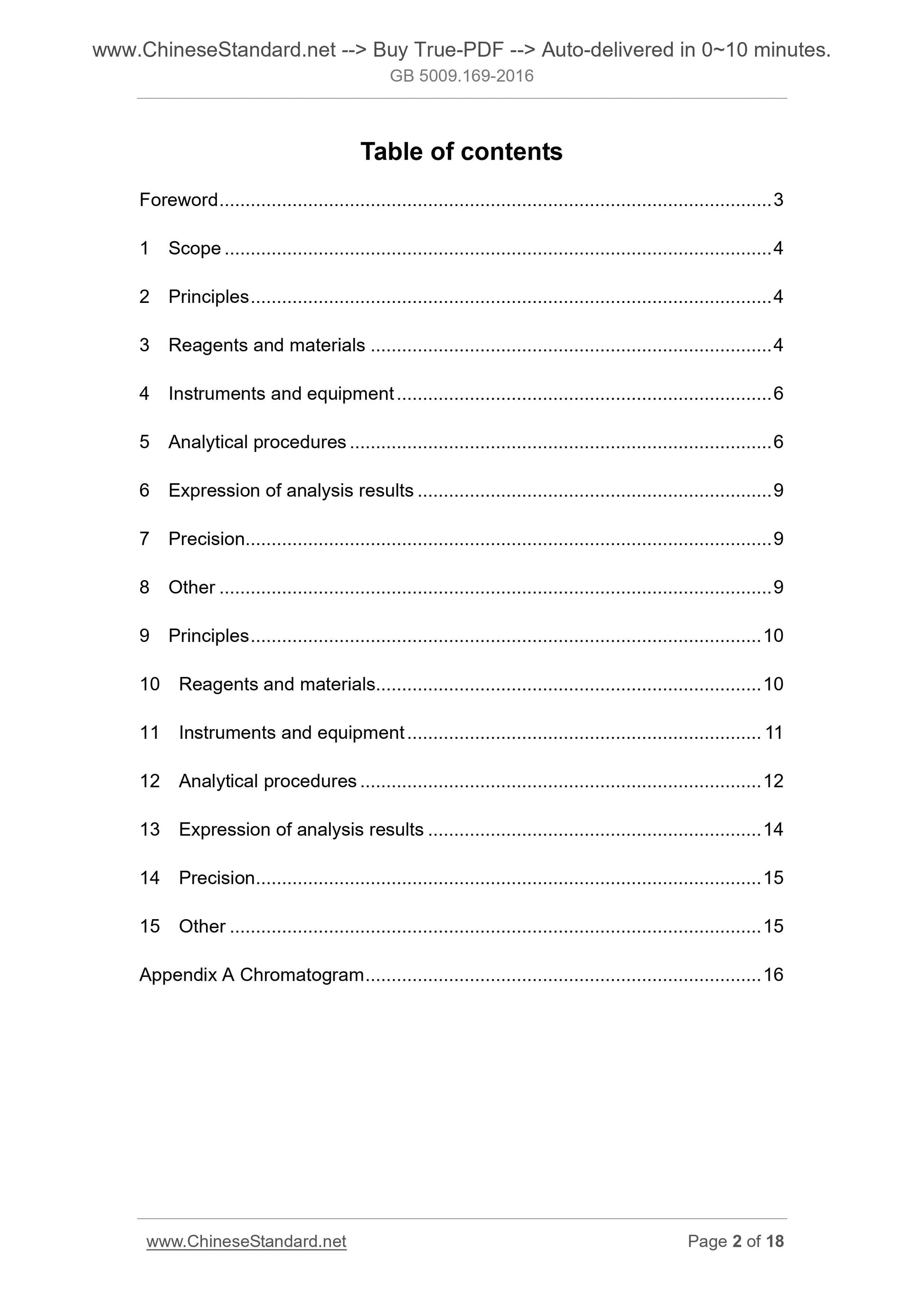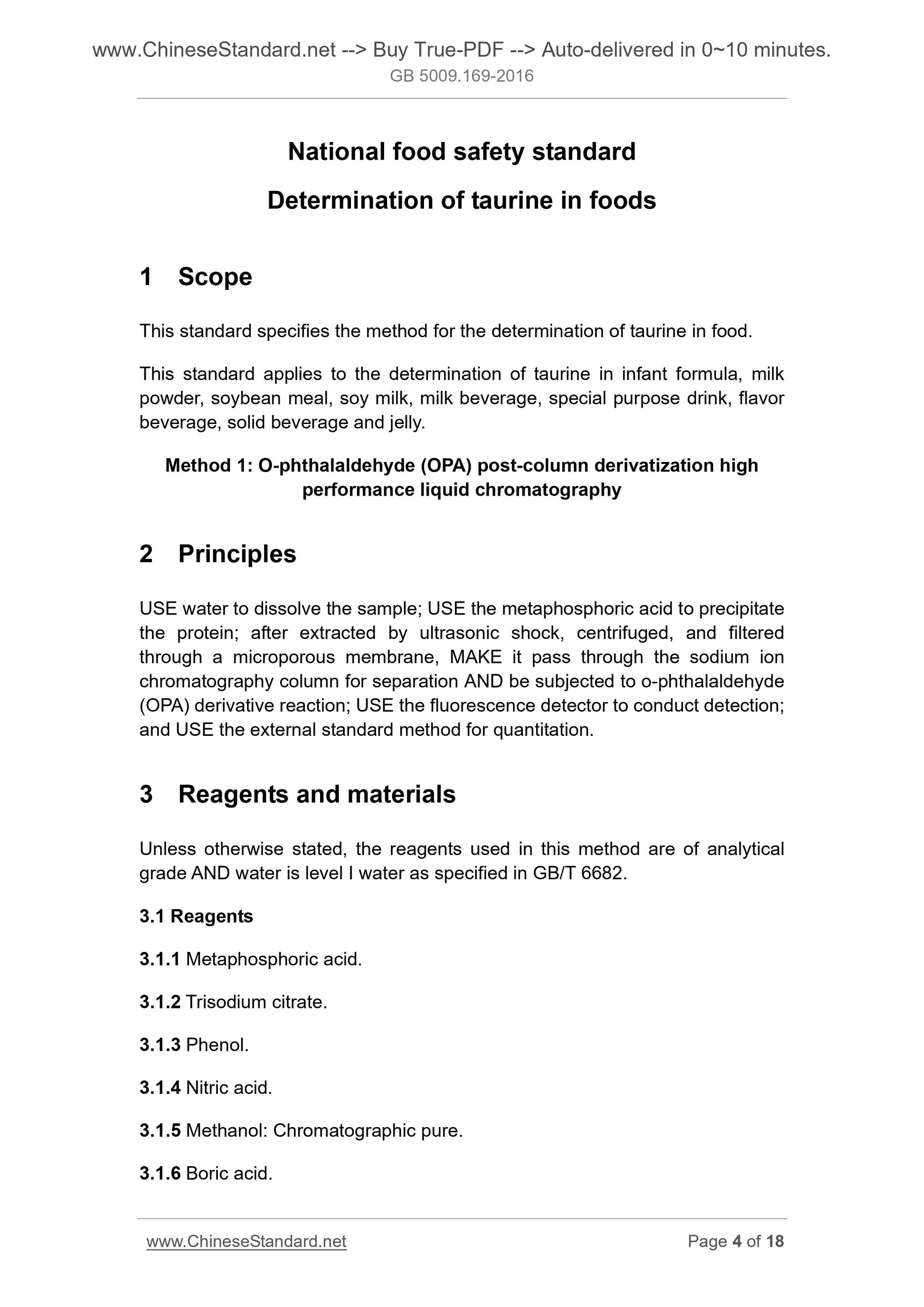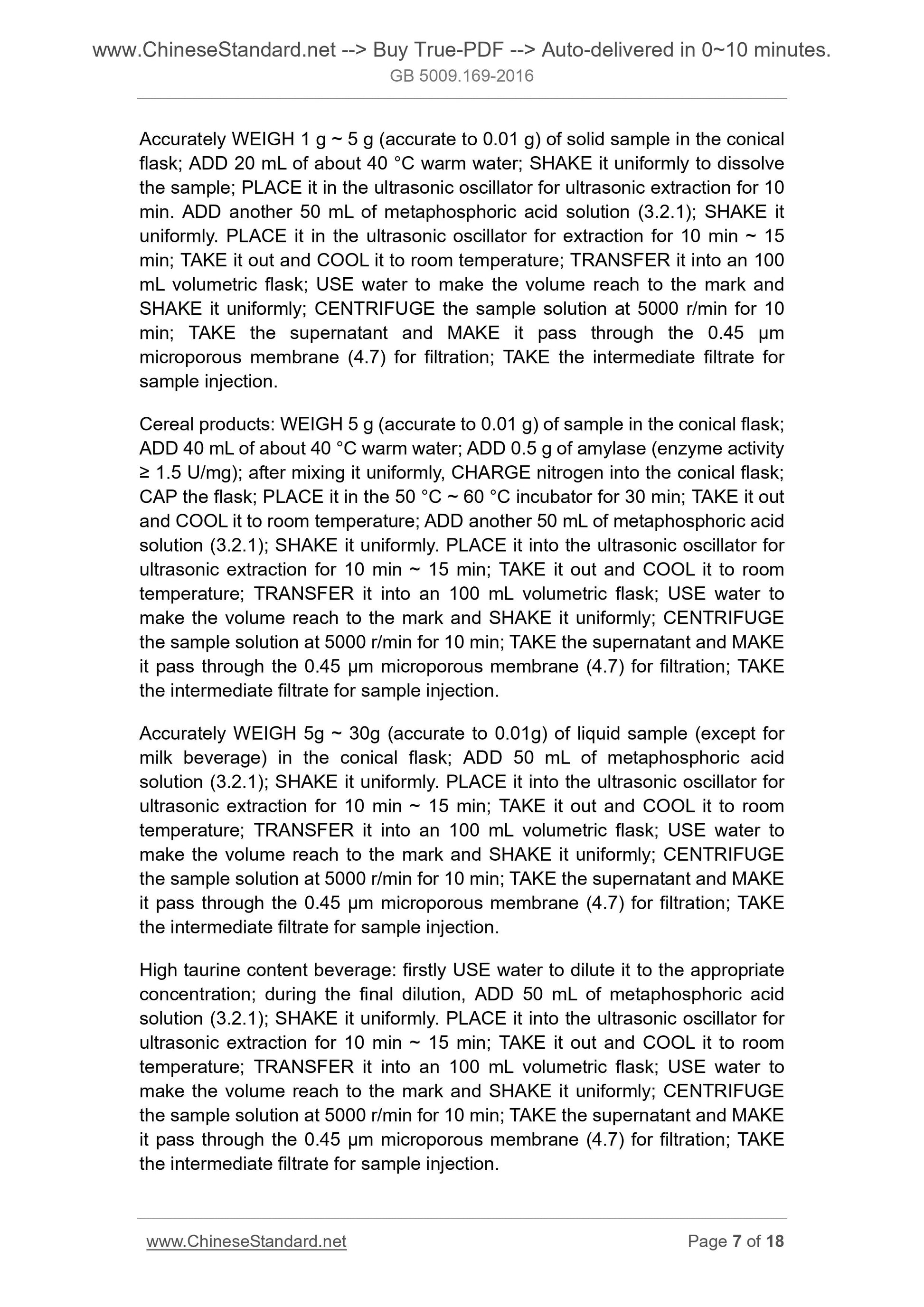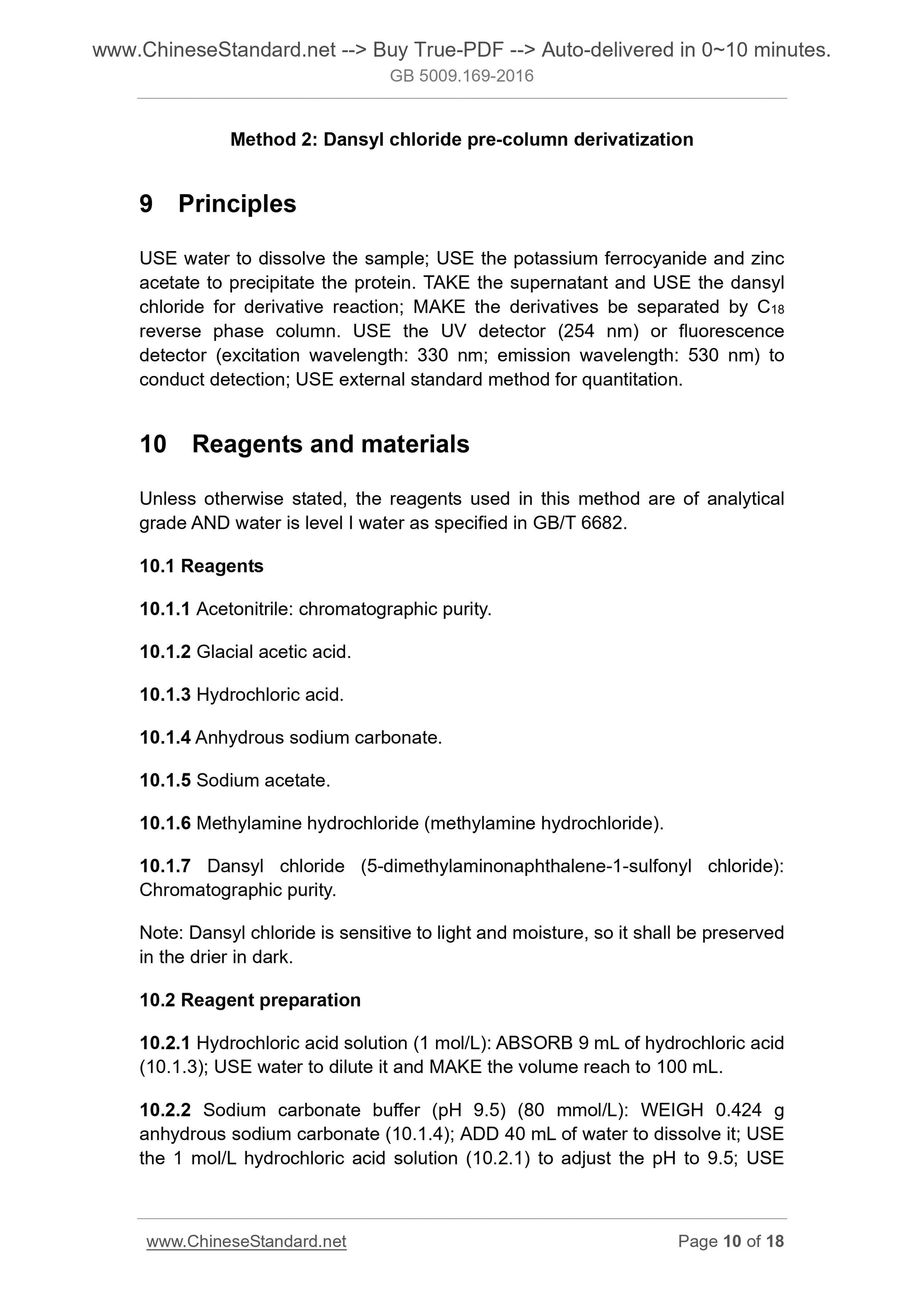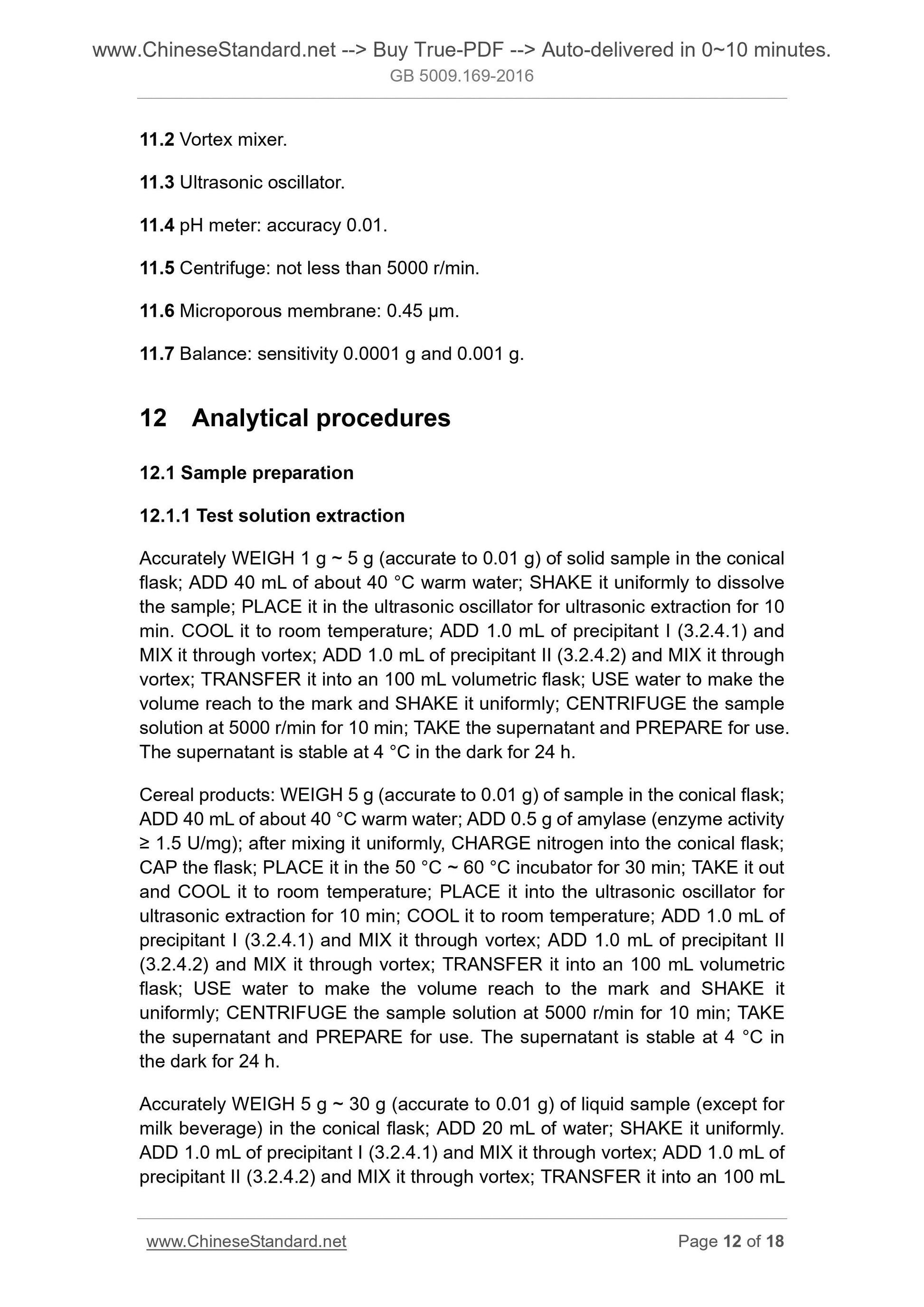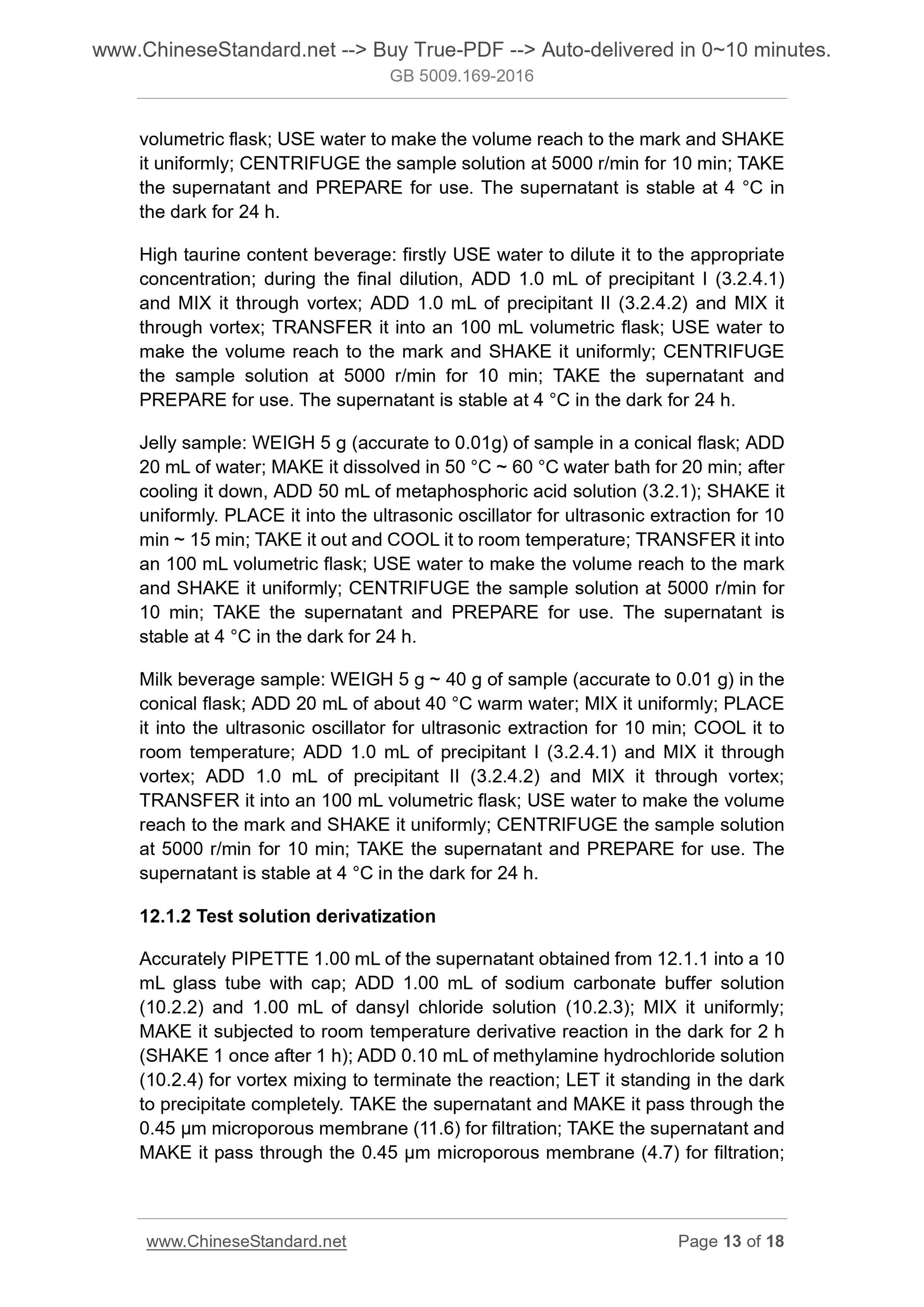1
/
of
7
PayPal, credit cards. Download editable-PDF & invoice in 1 second!
GB 5009.169-2016 English PDF (GB5009.169-2016)
GB 5009.169-2016 English PDF (GB5009.169-2016)
Regular price
$85.00 USD
Regular price
Sale price
$85.00 USD
Unit price
/
per
Shipping calculated at checkout.
Couldn't load pickup availability
Delivery: 3 seconds. Download true-PDF + Invoice.
Get QUOTATION in 1-minute: Click GB 5009.169-2016
Historical versions: GB 5009.169-2016
Preview True-PDF (Reload/Scroll if blank)
GB 5009.169-2016: National Food Safety Standard -- Determination of Taurine in Foods
GB 5009.169-2016
GB
NATIONAL STANDARD
OF THE PEOPLE’S REPUBLIC OF CHINA
National food safety standard
Determination of taurine in foods
ISSUED ON. AUGUST 31, 2016
IMPLEMENTED ON. MARCH 01, 2017
Issued by. National Health and Family Planning Commission of the PRC
Table of contents
Foreword ... 3
1 Scope ... 4
2 Principles ... 4
3 Reagents and materials ... 4
4 Instruments and equipment ... 6
5 Analytical procedures ... 6
6 Expression of analysis results ... 9
7 Precision... 9
8 Other ... 9
9 Principles ... 10
10 Reagents and materials... 10
11 Instruments and equipment ... 11
12 Analytical procedures ... 12
13 Expression of analysis results ... 14
14 Precision ... 15
15 Other ... 15
Appendix A Chromatogram ... 16
National food safety standard
Determination of taurine in foods
1 Scope
This standard specifies the method for the determination of taurine in food.
This standard applies to the determination of taurine in infant formula, milk
powder, soybean meal, soy milk, milk beverage, special purpose drink, flavor
beverage, solid beverage and jelly.
Method 1. O-phthalaldehyde (OPA) post-column derivatization high
performance liquid chromatography
2 Principles
USE water to dissolve the sample; USE the metaphosphoric acid to precipitate
the protein; after extracted by ultrasonic shock, centrifuged, and filtered
through a microporous membrane, MAKE it pass through the sodium ion
chromatography column for separation AND be subjected to o-phthalaldehyde
(OPA) derivative reaction; USE the fluorescence detector to conduct detection;
and USE the external standard method for quantitation.
3 Reagents and materials
Unless otherwise stated, the reagents used in this method are of analytical
grade AND water is level I water as specified in GB/T 6682.
3.1 Reagents
3.1.1 Metaphosphoric acid.
3.1.2 Trisodium citrate.
3.1.3 Phenol.
3.1.4 Nitric acid.
3.1.5 Methanol. Chromatographic pure.
3.1.6 Boric acid.
Accurately WEIGH 1 g ~ 5 g (accurate to 0.01 g) of solid sample in the conical
flask; ADD 20 mL of about 40 °C warm water; SHAKE it uniformly to dissolve
the sample; PLACE it in the ultrasonic oscillator for ultrasonic extraction for 10
min. ADD another 50 mL of metaphosphoric acid solution (3.2.1); SHAKE it
uniformly. PLACE it in the ultrasonic oscillator for extraction for 10 min ~ 15
min; TAKE it out and COOL it to room temperature; TRANSFER it into an 100
mL volumetric flask; USE water to make the volume reach to the mark and
SHAKE it uniformly; CENTRIFUGE the sample solution at 5000 r/min for 10
min; TAKE the supernatant and MAKE it pass through the 0.45 µm
microporous membrane (4.7) for filtration; TAKE the intermediate filtrate for
sample injection.
Cereal products. WEIGH 5 g (accurate to 0.01 g) of sample in the conical flask;
ADD 40 mL of about 40 °C warm water; ADD 0.5 g of amylase (enzyme activity
≥ 1.5 U/mg); after mixing it uniformly, CHARGE nitrogen into the conical flask;
CAP the flask; PLACE it in the 50 °C ~ 60 °C incubator for 30 min; TAKE it out
and COOL it to room temperature; ADD another 50 mL of metaphosphoric acid
solution (3.2.1); SHAKE it uniformly. PLACE it into the ultrasonic oscillator for
ultrasonic extraction for 10 min ~ 15 min; TAKE it out and COOL it to room
temperature; TRANSFER it into an 100 mL volumetric flask; USE water to
make the volume reach to the mark and SHAKE it uniformly; CENTRIFUGE
the sample solution at 5000 r/min for 10 min; TAKE the supernatant and MAKE
it pass through the 0.45 µm microporous membrane (4.7) for filtration; TAKE
the intermediate filtrate for sample injection.
Accurately WEIGH 5g ~ 30g (accurate to 0.01g) of liquid sample (except for
milk beverage) in the conical flask; ADD 50 mL of metaphosphoric acid
solution (3.2.1); SHAKE it uniformly. PLACE it into the ultrasonic oscillator for
ultrasonic extraction for 10 min ~ 15 min; TAKE it out and COOL it to room
temperature; TRANSFER it into an 100 mL volumetric flask; USE water to
make the volume reach to the mark and SHAKE it uniformly; CENTRIFUGE
the sample solution at 5000 r/min for 10 min; TAKE the supernatant and MAKE
it pass through the 0.45 µm microporous membrane (4.7) for filtration; TAKE
the intermediate filtrate for sample injection.
High taurine content beverage. firstly USE water to dilute it to the appropriate
concentration; during the final dilution, ADD 50 mL of metaphosphoric acid
solution (3.2.1); SHAKE it uniformly. PLACE it into the ultrasonic oscillator for
ultrasonic extraction for 10 min ~ 15 min; TAKE it out and COOL it to room
temperature; TRANSFER it into an 100 mL volumetric flask; USE water to
make the volume reach to the mark and SHAKE it uniformly; CENTRIFUGE
the sample solution at 5000 r/min for 10 min; TAKE the supernatant and MAKE
it pass through the 0.45 µm microporous membrane (4.7) for filtration; TAKE
the intermediate filtrate for sample injection.
Method 2. Dansyl chloride pre-column derivatization
9 Principles
USE water to dissolve the sample; USE the potassium ferrocyanide and zinc
acetate to precipitate the protein. TAKE the supernatant and USE the dansyl
chloride for derivative reaction; MAKE the derivatives be separated by C18
reverse phase column. USE the UV detector (254 nm) or fluorescence
detector (excitation wavelength. 330 nm; emission wavelength. 530 nm) to
conduct detection; USE external standard method for quantitation.
10 Reagents and materials
Unless otherwise stated, the reagents used in this method are of analytical
grade AND water is level I water as specified in GB/T 6682.
10.1 Reagents
10.1.1 Acetonitrile. chromatographic purity.
10.1.2 Glacial acetic acid.
10.1.3 Hydrochloric acid.
10.1.4 Anhydrous sodium carbonate.
10.1.5 Sodium acetate.
10.1.6 Methylamine hydrochloride (methylamine hydrochloride).
10.1.7 Dansyl chloride (5-dimethylaminonaphthalene-1-sulfonyl chloride).
Chromatographic purity.
Note. Dansyl chloride is sensitive to light and moisture, so it shall be preserved
in the drier in dark.
10.2 Reagent preparation
10.2.1 Hydrochloric acid solution (1 mol/L). ABSORB 9 mL of hydrochloric acid
(10.1.3); USE water to dilute it and MAKE the volume reach to 100 mL.
10.2.2 Sodium carbonate buffer (pH 9.5) (80 mmol/L). WEIGH 0.424 g
anhydrous sodium carbonate (10.1.4); ADD 40 mL of water to dissolve it; USE
the 1 mol/L hydrochloric acid solution (10.2.1) to adjust the pH to 9.5; USE
11.2 Vortex mixer.
11.3 Ultrasonic oscillator.
11.4 pH meter. accuracy 0.01.
11.5 Centrifuge. not less than 5000 r/min.
11.6 Microporous membrane. 0.45 μm.
11.7 Balance. sensitivity 0.0001 g and 0.001 g.
12 Analytical procedures
12.1 Sample preparation
12.1.1 Test solution extraction
Accurately WEIGH 1 g ~ 5 g (accurate to 0.01 g) of solid sample in the conical
flask; ADD 40 mL of about 40 °C warm water; SHAKE it uniformly to dissolve
the sample; PLACE it in the ultrasonic oscillator for ultrasonic extraction for 10
min. COOL it to room temperature; ADD 1.0 mL of precipitant I (3.2.4.1) and
MIX it through vortex; ADD 1.0 mL of precipitant II (3.2.4.2) and MIX it through
vortex; TRANSFER it into an 100 mL volumetric flask; USE water to make the
volume reach to the mark and SHAKE it uniformly; CENTRIFUGE the sample
solution at 5000 r/min for 10 min; TAKE the supernatant and PREPARE for use.
The supernatant is stable at 4 °C i...
Get QUOTATION in 1-minute: Click GB 5009.169-2016
Historical versions: GB 5009.169-2016
Preview True-PDF (Reload/Scroll if blank)
GB 5009.169-2016: National Food Safety Standard -- Determination of Taurine in Foods
GB 5009.169-2016
GB
NATIONAL STANDARD
OF THE PEOPLE’S REPUBLIC OF CHINA
National food safety standard
Determination of taurine in foods
ISSUED ON. AUGUST 31, 2016
IMPLEMENTED ON. MARCH 01, 2017
Issued by. National Health and Family Planning Commission of the PRC
Table of contents
Foreword ... 3
1 Scope ... 4
2 Principles ... 4
3 Reagents and materials ... 4
4 Instruments and equipment ... 6
5 Analytical procedures ... 6
6 Expression of analysis results ... 9
7 Precision... 9
8 Other ... 9
9 Principles ... 10
10 Reagents and materials... 10
11 Instruments and equipment ... 11
12 Analytical procedures ... 12
13 Expression of analysis results ... 14
14 Precision ... 15
15 Other ... 15
Appendix A Chromatogram ... 16
National food safety standard
Determination of taurine in foods
1 Scope
This standard specifies the method for the determination of taurine in food.
This standard applies to the determination of taurine in infant formula, milk
powder, soybean meal, soy milk, milk beverage, special purpose drink, flavor
beverage, solid beverage and jelly.
Method 1. O-phthalaldehyde (OPA) post-column derivatization high
performance liquid chromatography
2 Principles
USE water to dissolve the sample; USE the metaphosphoric acid to precipitate
the protein; after extracted by ultrasonic shock, centrifuged, and filtered
through a microporous membrane, MAKE it pass through the sodium ion
chromatography column for separation AND be subjected to o-phthalaldehyde
(OPA) derivative reaction; USE the fluorescence detector to conduct detection;
and USE the external standard method for quantitation.
3 Reagents and materials
Unless otherwise stated, the reagents used in this method are of analytical
grade AND water is level I water as specified in GB/T 6682.
3.1 Reagents
3.1.1 Metaphosphoric acid.
3.1.2 Trisodium citrate.
3.1.3 Phenol.
3.1.4 Nitric acid.
3.1.5 Methanol. Chromatographic pure.
3.1.6 Boric acid.
Accurately WEIGH 1 g ~ 5 g (accurate to 0.01 g) of solid sample in the conical
flask; ADD 20 mL of about 40 °C warm water; SHAKE it uniformly to dissolve
the sample; PLACE it in the ultrasonic oscillator for ultrasonic extraction for 10
min. ADD another 50 mL of metaphosphoric acid solution (3.2.1); SHAKE it
uniformly. PLACE it in the ultrasonic oscillator for extraction for 10 min ~ 15
min; TAKE it out and COOL it to room temperature; TRANSFER it into an 100
mL volumetric flask; USE water to make the volume reach to the mark and
SHAKE it uniformly; CENTRIFUGE the sample solution at 5000 r/min for 10
min; TAKE the supernatant and MAKE it pass through the 0.45 µm
microporous membrane (4.7) for filtration; TAKE the intermediate filtrate for
sample injection.
Cereal products. WEIGH 5 g (accurate to 0.01 g) of sample in the conical flask;
ADD 40 mL of about 40 °C warm water; ADD 0.5 g of amylase (enzyme activity
≥ 1.5 U/mg); after mixing it uniformly, CHARGE nitrogen into the conical flask;
CAP the flask; PLACE it in the 50 °C ~ 60 °C incubator for 30 min; TAKE it out
and COOL it to room temperature; ADD another 50 mL of metaphosphoric acid
solution (3.2.1); SHAKE it uniformly. PLACE it into the ultrasonic oscillator for
ultrasonic extraction for 10 min ~ 15 min; TAKE it out and COOL it to room
temperature; TRANSFER it into an 100 mL volumetric flask; USE water to
make the volume reach to the mark and SHAKE it uniformly; CENTRIFUGE
the sample solution at 5000 r/min for 10 min; TAKE the supernatant and MAKE
it pass through the 0.45 µm microporous membrane (4.7) for filtration; TAKE
the intermediate filtrate for sample injection.
Accurately WEIGH 5g ~ 30g (accurate to 0.01g) of liquid sample (except for
milk beverage) in the conical flask; ADD 50 mL of metaphosphoric acid
solution (3.2.1); SHAKE it uniformly. PLACE it into the ultrasonic oscillator for
ultrasonic extraction for 10 min ~ 15 min; TAKE it out and COOL it to room
temperature; TRANSFER it into an 100 mL volumetric flask; USE water to
make the volume reach to the mark and SHAKE it uniformly; CENTRIFUGE
the sample solution at 5000 r/min for 10 min; TAKE the supernatant and MAKE
it pass through the 0.45 µm microporous membrane (4.7) for filtration; TAKE
the intermediate filtrate for sample injection.
High taurine content beverage. firstly USE water to dilute it to the appropriate
concentration; during the final dilution, ADD 50 mL of metaphosphoric acid
solution (3.2.1); SHAKE it uniformly. PLACE it into the ultrasonic oscillator for
ultrasonic extraction for 10 min ~ 15 min; TAKE it out and COOL it to room
temperature; TRANSFER it into an 100 mL volumetric flask; USE water to
make the volume reach to the mark and SHAKE it uniformly; CENTRIFUGE
the sample solution at 5000 r/min for 10 min; TAKE the supernatant and MAKE
it pass through the 0.45 µm microporous membrane (4.7) for filtration; TAKE
the intermediate filtrate for sample injection.
Method 2. Dansyl chloride pre-column derivatization
9 Principles
USE water to dissolve the sample; USE the potassium ferrocyanide and zinc
acetate to precipitate the protein. TAKE the supernatant and USE the dansyl
chloride for derivative reaction; MAKE the derivatives be separated by C18
reverse phase column. USE the UV detector (254 nm) or fluorescence
detector (excitation wavelength. 330 nm; emission wavelength. 530 nm) to
conduct detection; USE external standard method for quantitation.
10 Reagents and materials
Unless otherwise stated, the reagents used in this method are of analytical
grade AND water is level I water as specified in GB/T 6682.
10.1 Reagents
10.1.1 Acetonitrile. chromatographic purity.
10.1.2 Glacial acetic acid.
10.1.3 Hydrochloric acid.
10.1.4 Anhydrous sodium carbonate.
10.1.5 Sodium acetate.
10.1.6 Methylamine hydrochloride (methylamine hydrochloride).
10.1.7 Dansyl chloride (5-dimethylaminonaphthalene-1-sulfonyl chloride).
Chromatographic purity.
Note. Dansyl chloride is sensitive to light and moisture, so it shall be preserved
in the drier in dark.
10.2 Reagent preparation
10.2.1 Hydrochloric acid solution (1 mol/L). ABSORB 9 mL of hydrochloric acid
(10.1.3); USE water to dilute it and MAKE the volume reach to 100 mL.
10.2.2 Sodium carbonate buffer (pH 9.5) (80 mmol/L). WEIGH 0.424 g
anhydrous sodium carbonate (10.1.4); ADD 40 mL of water to dissolve it; USE
the 1 mol/L hydrochloric acid solution (10.2.1) to adjust the pH to 9.5; USE
11.2 Vortex mixer.
11.3 Ultrasonic oscillator.
11.4 pH meter. accuracy 0.01.
11.5 Centrifuge. not less than 5000 r/min.
11.6 Microporous membrane. 0.45 μm.
11.7 Balance. sensitivity 0.0001 g and 0.001 g.
12 Analytical procedures
12.1 Sample preparation
12.1.1 Test solution extraction
Accurately WEIGH 1 g ~ 5 g (accurate to 0.01 g) of solid sample in the conical
flask; ADD 40 mL of about 40 °C warm water; SHAKE it uniformly to dissolve
the sample; PLACE it in the ultrasonic oscillator for ultrasonic extraction for 10
min. COOL it to room temperature; ADD 1.0 mL of precipitant I (3.2.4.1) and
MIX it through vortex; ADD 1.0 mL of precipitant II (3.2.4.2) and MIX it through
vortex; TRANSFER it into an 100 mL volumetric flask; USE water to make the
volume reach to the mark and SHAKE it uniformly; CENTRIFUGE the sample
solution at 5000 r/min for 10 min; TAKE the supernatant and PREPARE for use.
The supernatant is stable at 4 °C i...
Share
